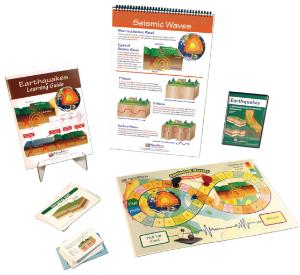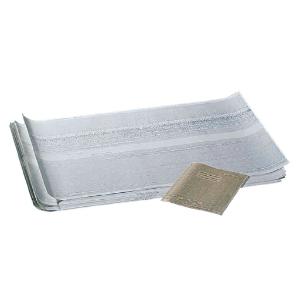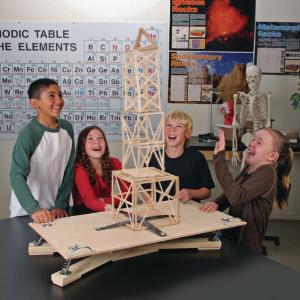Shake Things Up with Earthquake Engineering and a Free AccessScience Download
Access to this content is available to Ward’s World readers for free from McGraw Hill’s AccessScience, an award-winning, digital STEM resource that provides immediate, authoritative answers to students’ thirst for scientific knowledge on topics such as climate change, virology, pollution, and more. Ward’s World and McGraw Hill have partnered to offer educators a no-obligation, free trial subscription to this product. Request your free trial today and discover how valuable AccessScience can be for you and your students.
High School
Let’s get ready to rumble!!!
Earthquakes are among our planet's most awe-inspiring natural phenomena, capable of unleashing immense energy, reshaping landscapes, and challenging the resilience of human-made structures. Imagine the Earth's crust as a giant puzzle with pieces (tectonic plates) that sometimes slide, grind, or collide, setting off rumbles that can be felt across vast distances. Scientists, engineers, and curious minds have been fascinated by seismic events for centuries. Earthquake engineering uncovers the secrets and structural designs that can withstand this formidable force.
Earthquake engineering helps students discover the core of our planet's geological processes, the ingenuity of human invention, and the dynamics between science and engineering. Here are a few shocking facts they’ll enjoy learning:
- Earthquakes Aren't Random: Earthquakes are not arbitrary events. They mainly occur along tectonic plate boundaries in the Earth’s lithosphere (crust and upper mantle), where colossal pieces of the Earth's crust interact. This is where you'll find some of the most earthquake-prone regions, such as the circum-Pacific Ring of Fire, which accounts for about 90% of the world's earthquakes.
- It’s All in The Numbers: There are several million earthquakes annually. Around 17 major earthquakes measure above 7.0 on the Richter scale – and one great earthquake measures above 8.0 – each year. However, experts estimate several million earthquakes go undetected annually due to their geographical remoteness or small magnitude.1
- Magnitude Matters: There are several ways to measure the magnitude of an earthquake. Most scales are based on the amplitude of seismic waves recorded on seismometers. An earthquake releases 31.6 times more energy for every unit increase in magnitude. A magnitude 7 earthquake is more than a thousand times stronger than a magnitude 5 quake! To put that in perspective, a magnitude 1 seismic wave releases as much energy as blowing up 6 ounces of TNT, while a magnitude 8 earthquake releases as much energy as 6 million tons!2
- Ground-Shaking Dangers: Earthquakes not only shake the ground but can also trigger landslides, tsunamis, and aftershocks. Tsunamis that cause damage or deaths near their source occur approximately twice yearly.3 Understanding the ripple effects of seismic activity is crucial for engineers designing safe structures.
- Earthquake-Resistant Buildings: Earthquake engineering has created innovative building designs, such as base isolators and tuned mass dampers, that allow structures to sway and absorb seismic energy. The Skytree Tower in Tokyo is the third tallest building in the world (as of 2023). Its design includes a central pillar attached to seismic dampers that together absorb the energy of an earthquake.
- Early Warning Systems: Scientists are developing early warning systems that give people precious seconds or minutes to take cover or evacuate before the most destructive shockwaves happen. ShakeAlert, for example, is the public earthquake early warning system implemented in California, Oregon, and Washington. The system is based on an algorithm the UC Berkeley Seismological Laboratory developed.4
So, fasten your seatbelts and prepare your class to explore the groundbreaking science behind earthquakes and the ingenious technologies that mitigate their impact.
Download the McGraw Hill’s AccessScience article, Earthquake Engineering, covering seismic research, activities, hazards, and current approaches to structural designs. The free download also includes assessment questions and answers you can use to test student understanding.
1. United States Geological Survey. 2. Michigan Tech: How Do We Measure Earthquake Magnitude? 3. Global Historical Tsunami Database. 4. UC Berkley Seismology Lab: What if you had a warning before earthquake shaking?
Recommended Products
[StartProductBlock]

Earthquakes Curriculum Learning Module
Provides digital and hands-on resources to provide the skills to master key concepts on earthquakes. An engaging blend of technology-based instruction, interactive print resources, and game-based learning.
[EndProductBlock]
[StartProductBlock]

The 1964 Alaskan Earthquake Lab Activity
Real data from one of the most thoroughly documented earthquakes in history. Measure, study, and interpret copies of seismograms recorded over 48 hours.
[EndProductBlock]
[StartProductBlock]

Shake, Rattle & Roll Earthquake Board
This wave maker earthquake board and kit makes seismic waves in the classroom.
[EndProductBlock]
